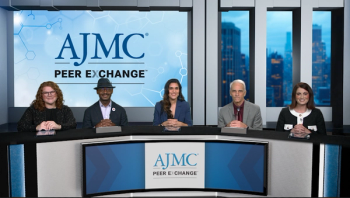
The RRMM Patient Journey: Part 1
Expert panelists discuss considerations for RRMM treatment strategies.
Episodes in this series

Jeffrey Matous, MD: To the panelists, you all work in very large systems that treat a large number of patients with myeloma. How much heterogeneity is there in the initial therapy of patients with myeloma? How might that affect how we address relapsing disease?
Kirollos Hanna, PharmD, BCPS, BCOP, FACCC: Quite a bit. You look at even the frontline management of your patient population. Back in the day, you had your VRd [Velcade (bortezomib), Revlimid (lenalidomide), and dexamethasone] and your CyBorD [Cyclophosphamide, bortezomib, and dexamethasone]. Renal impairment. You gave them Cytoxan [cyclophosphamide]. You had good renal impairment. You went the lenalidomide route. Then if they improved, you could switch. But now, look at the GRIFFIN trial, look at CD38 moving into that frontline setting. There is a school of thought out there about do we even need to transplant this patient population anymore. Some are on the line of maybe we can move away from it, maybe not.
But back to the point, we were talking about a little bit earlier of since you lose that attrition throughout the lines of therapy, you start to lose a lot of patients. Putting your best foot forward. Doing a DARA [daratumumab (Darzalex)]-containing regimen upfront, something like the GRIFFIN trial and DARA maintenance or not, and trying to achieve MRD [minimal residual disease] negativity early on into the treatment paradigm, does that help in terms of the overall outcomes of disease? There’s definitely a lot of heterogeneity to your point.
Jeffrey Matous, MD: Beth, can I ask you a question? What’s a typical approach to an initially diagnosed patient? How do they go from the initial diagnosis to the relapsed/refractory setting? What kind of treatments are you seeing these days?
Beth Faiman, PhD, APN-BC, CM: Absolutely. We were a center for many years. I’ve been at Cleveland Clinic since 1994. We did not do transplants in earlier years. In the last 10 to 15 years, we’ve been doing more transplants for patients if they’re transplant eligible. We decide if the patient is eligible for transplant or not and is there an available clinical trial. Because there are so many new clinical trials out there, and we can’t advance science unless we offer them to our patients, we try to offer everybody a clinical trial. If they don’t want it, that’s OK. We won’t be too sad. We’ll probably, if they have a high-risk disease, do a carfilzomib [Kyprolis]-containing regimen or DARA [daratumumab]/VRd as in the GRIFFIN trial. If they’re transplant-ineligible, we are doing either VRd-lite, if they have standard-risk disease, or DRd [daratumumab lenalidomide dexamethasone] as in the MAIA trial. That’s our standard of care.
We have maintenance studies after the transplant. We have the ECOG study, which is lenalidomide maintenance plus or minus daratumumab. Other than that, we’re watching them very closely whether they’re in the community or here. I do a lot of virtual visits with my patients that live far away. I say go back to your regular hospital and then dial in with me on a virtual visit every 3 months, 6 months, annually. Let’s talk about your health supportive care such as bone health. Are you being active? DVT [deep vein thrombosis] prevention, infection, all that kind of stuff. Then you’re watching them so that it's more of a biochemical relapse than a fulminant symptomatic relapse.
Jeffrey Matous, MD: What’s going on in Kansas these days, Zahra?
Zahra Mahmoudjafari, PharmD, MBA, BCOP, FHOPA: Very similar. We have certainly any time you open the NCCN [National Comprehensive Cancer Network] guidelines for centers that are not as familiar with multiple myeloma, it is confusing. You open that table and there are a lot of different category 1 recommendations. I would say the CD38 antibodies have definitely taken a mainstay hold very similar to what’s being described at Cleveland Clinic in Ohio. Because we are a large referral center, sometimes the first-line and second-line options have been chosen for us. We have to take a peek at exactly what Beth was mentioning in terms of where they are in their treatment, what they’ve received previously, and trying to create the best regimen for them. That’s really important for us and is very similar to what’s being described at Cleveland Clinic.
Jeffrey Matous, MD: What’s the quadruplet penetration been in Minnesota?
Kirollos Hanna, PharmD, BCPS, BCOP, FACCC: I would say maybe ¼ of our patients that I’m seeing are coming through with doing a 4-drug-based regimen. Really incorporating that CD38 early on. You look at the data of the MAIA trial, the CASSIOPEIA trial, you look at the GRIFFIN trial, it’s favoring the incorporation of that, especially in your patients at least with high-risk cytogenetics. There’s really an unmet need there in that patient population in terms of relapse rates as well as whether or not they are transplant eligible. We’re definitely seeing a good portion of our patients starting to transition to 4-drug-based regimens or even more.
Jeffrey Matous, MD: For the panel. Let’s just say we have a patient who got DARA [daratumumab]/RVd [lenalidomide/bortezomib/dexamethasone] upfront. They got their transplant. Now if they really got all the GRIFFIN trial treatment, we’re waiting a long time for them to relapse in general. Let’s just say they got treatment; they got a quad and here they are in their first relapse. You’ve been through 4 of your really good drugs. What’s being given in the next line?
Beth Faiman, PhD, APN-BC, CM: A Kyprolis-, or carfilzomib, containing regimen with Pom/dex [pomalidomide (Pomalyst) plus dexamethasone] usually or a clinical trial. We have CELMoDs [cereblon E3 ligase modulators] that are out. We have selinexor [Xpovio]-based therapies, and I think the STORM trial that looked at selinexor efficacy and safety was in high doses with dexamethasone. A lot of GI [gastrointestinal] toxicity, weight loss. But the dose was twice weekly selinexor with not great supportive care upfront. Now I’m seeing that if you give more that was a 26% response rate, so it wasn’t a home run. But they were pentao refractory people.
Now, when you move it earlier into the first-, second-, or third-line therapy of relapse they can tolerate it a lot better at a dose of like 60 mg. Although 100 mg is the recommended dose, we do 60 mg with carfilzomib. They’re in, you can give them fluids and I give them olanzapine [Zyprexa] at bedtime.
That supportive care becomes so important in giving some of these drugs upfront, especially in standard-risk disease. But we typically will go, and that’s if they want an all-oral regimen, we’ll do sometimes with pomalidomide. But definitely, the carfilzomib, Pom [pomalidomide]/dex [dexamethasone] would be the second line as long as they don’t have a lot of cardiac toxicity, no concurrent cardiac amyloidosis, or any of those other risk factors. Can I ask you how you manage your patients with carfilzomib? Do you worry about echocardiograms or EKGs, NT-proBNP [N-terminal pro—B-type natriuretic peptide]? What’s your standard of care?
Zahra Mahmoudjafari, PharmD, MBA, BCOP, FHOPA: Absolutely. I think monitoring supportive care is a big mainstay in multiple myeloma care. Just given all the renal dysfunction, the bone lesions, etc. There’s a lot that goes on. Carfilzomib is no exception with the monitoring. The cardiotoxicity is routinely monitored. We certainly monitor for peripheral neuropathy. There’s lots of supportive care that comes along. I’m curious, you didn’t get to answer that question. What do you do?
Beth Faiman, PhD, APN-BC, CM: He’s the moderator.
Jeffrey Matous, MD: Pretty much what Beth said, which is if you got DARA [daratumumab]/RVd, or if you got some kind of quad, then you’re going to go with a different PI [proteasome inhibitor]. You’re going to go with carfilzomib. You’re going to switch to pomalidomide. You may or may not incorporate the CD38 back in depending on how long it’s been since you last had a CD38.
Beth Faiman, PhD, APN-BC, CM: If it was just induction.
Jeffrey Matous, MD: Maybe you didn’t get it in maintenance. You think about that. But I always say the second line is usually—and DARA [daratumumab]/Pom [pomalidomide]/dex [dexamethasone] is very common at our place. They haven’t seen that for a while. Then the third line tends to be whatever you didn’t get in second line. Whatever combination you get second line, the next line is where we get all the questions. I used to call them belantamab [Blenrep] patients or the selinexor patients. Those are the patients where I think it’s ripe for clinical trials and exploring things and so forth.
Transcript edited for clarity.
Newsletter
Stay ahead of policy, cost, and value—subscribe to AJMC for expert insights at the intersection of clinical care and health economics.








































